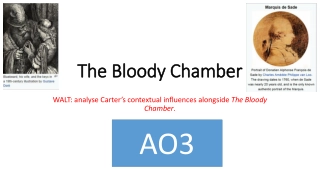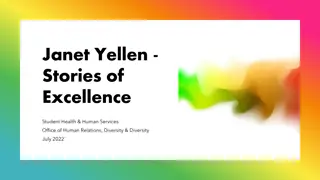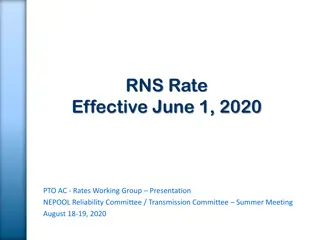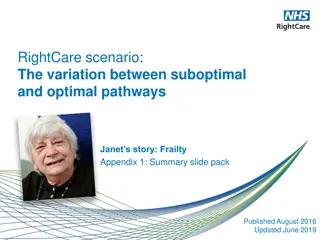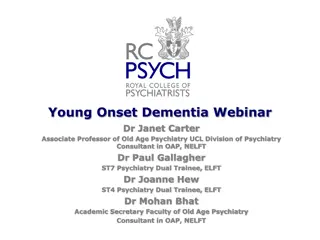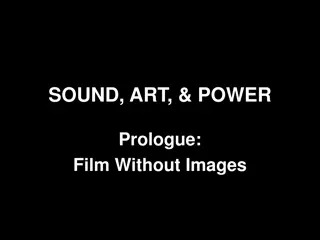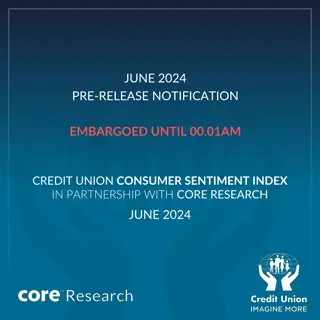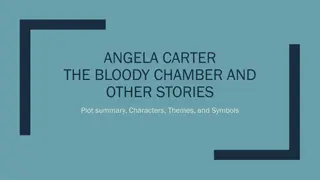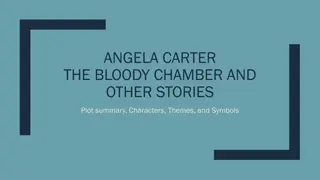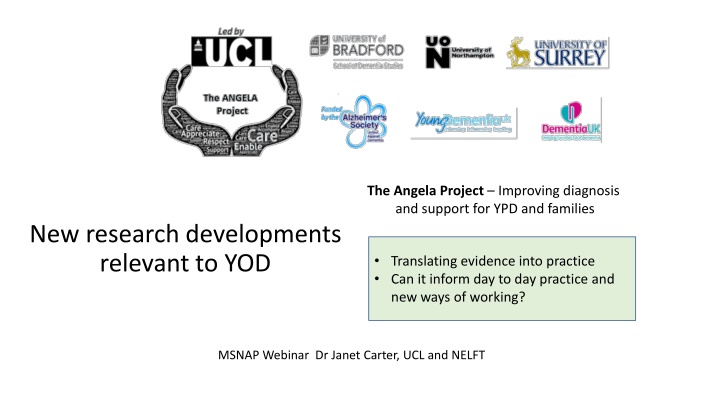
Improving Diagnosis and Support for Young-Onset Dementia (YOD): New Research Perspectives
Explore the latest research findings from the Angela Project, focusing on improving the diagnosis and support for individuals with Young-Onset Dementia (YOD) and their families. Discover how quality indicators and standards can enhance diagnosis, patient experience, and post-diagnostic support. Delve into the challenges faced in diagnosing YOD, recommendations for service design, and the outcomes of the Delphi-PRO study involving international clinical experts.
Uploaded on | 1 Views
Download Presentation

Please find below an Image/Link to download the presentation.
The content on the website is provided AS IS for your information and personal use only. It may not be sold, licensed, or shared on other websites without obtaining consent from the author. If you encounter any issues during the download, it is possible that the publisher has removed the file from their server.
You are allowed to download the files provided on this website for personal or commercial use, subject to the condition that they are used lawfully. All files are the property of their respective owners.
The content on the website is provided AS IS for your information and personal use only. It may not be sold, licensed, or shared on other websites without obtaining consent from the author.
E N D
Presentation Transcript
The Angela Project Improving diagnosis and support for YPD and families New research developments relevant to YOD Translating evidence into practice Can it inform day to day practice and new ways of working? MSNAP Webinar Dr Janet Carter, UCL and NELFT
Main questions from the study Main questions from the study improving diagnosis and support improving diagnosis and support Can we identify quality indicators/standards to improve diagnosis? Can we improve patient experience understand what matters most? Can we assess how well we currently perform? case note audit Can we understand what works best for support after diagnosis?
https://www.youngdementiauk.org/angela-project Recommendations for service design and development, care planning
Issuespsychosocial and clinical differences to LOD delay to diagnosis misdiagnosis under-investigation poor patient experience Routine assessments tailored to older patients are insufficient to identify the complex presentations of YOD
Delphi-PRO(fessional) 23 international clinical experts Delphi Study Delphi Study Method Method Identify quality indicators for making an accurate diagnosis of YOD? -iterative questionnaire -translates professional experience into clinical decision making 48 Delphi-PRO - clinical indicators 33 indicators for the Gold Standard (80% consensus) - forces consensus 11 for Minimum Standard (100% consensus)
Examples of quality indicators reaching 80% consensus in grey STATEMENT CATEGORY Psychiatric History and symptom enquiry 6.1. Take a thorough psychiatric history 7.1. Exclude Symptoms of mood disorder 7.3. Exclude psychotic symptoms 7.7. Include a mental state examination Physical examination 3.4. A Physical Examination should be conducted
Examples of quality indicators Imaging 12.1. Do baseline structural neuroimaging (22/23) 12.6. Do an MRI dementia protocol incorporating T1, T2 and Flair images (19/23) 12.5. Assess Medial Temporal Lobe atrophy on MRI volumetric analysis Only 4/23 thought CT preferable -------------------------------------------------------------------------------------------------------------------------------------------------------------------- A basic/routine dementia blood screen CSF analysis for biomarkers i.e. TAU and AB42 markers A chest x-ray Examples of AMYLOID-PET if available Statements not reaching consensus An ECG CT A screen for autoimmune disorders To enquire if there are any swallowing difficulties Volumetric analysis of MRI Use a mood inventory such as GDS, BDI, HADS Use a mood inventory such as GDS, BDI, HADS To assess for previous head injuries Use an inventory for neuropsychiatric symptoms such as NPI To ask about stressful life events
Statements rated by 100% of experts as essential MINIMUM STANDARD Diagnosis of YOD is a clinical judgement and has a profound impact on the future, so it important to convey this to patient and their family and remain open to the need to review and potentially modify opinion Establishing rapport to enable open reporting of symptoms To ask an informant (e.g. wife/husband) for a collateral history To understand the symptom type and the mode of onset Enquire about loss of sympathy/empathy towards others, disinhibited behaviour, change in food preferences and changes in personality To enquire about changes in physical health If there have been any changes in activities of daily living To ask about changes in behaviour To ask if a first degree relative has had young onset dementia To have a full medical history (including cardiovascular history) A thorough neurological assessment should be conducted
Example of gold standard indicators Pre-assessment and communication The assessment should start with counselling to ascertain what patient and supporters require Pre-assessment and communication Ensuring the patient has capacity Neuroimaging include Visual assessment of MTL atrophy on MRI Neuropsychological assessment An ACE* -3 is useful to understand the cognitive profile Neuropsychological assessment Patterns of cognitive deficits provide clues to disease aetiology on the ACE-3 Neuropsychological assessment Detailed neuropsychology testing should be considered if there is under-performance on screening measures Neurological examination: examine for Eye movements Cerebellar signs Tongue or limb fasciculation Frontal signs Extrapyramidal features Motor Skills
Delphi participants were 18 people living with young onset dementia, and 18 supporters. Recruited from across England (NHS & third sector) Delphi-EXP(erience) Two Round Process. Round 1 participants answered open-ended questions (relating to referral, assessment and diagnosis). What matters most to YPD and families/supporters Round 2 participants rated the derived statements. relating to the referral, assessment and diagnosis process. 27 statements were rated on average absolutely essential or very important.
Functional factors the process Appointment - Ensure there is enough notice between letters being issued and appointment Convenience - Making appointments convenient for working adults Follow-up letter Contact family supporters as well - Healthcare professionals should make contact with family supporters if unable to get through to the person with dementia directly regarding appointments Providing the person with dementia and their supporters with a letter which details the diagnosis Single point of contact - Having an identified key person as a single point of contact throughout the whole diagnostic process Referrals to specialist services - Referrals should ideally be made to specialist YOD clinicians and services Multi-disciplinary team There should be a multi- disciplinary team involved in diagnosis to provide appropriate support GP Quick Referral - The referral process from GP to first assessment needs to be shorter Home visits Patients should be seen at home for assessments and post-diagnostic support where appropriate Enhanced awareness of YOD - More awareness and training on rarer dementia types as well as the issues faced by young people with dementia in Mental Health Trusts. Pleasant MRI experience - The MRI experience should provide blankets, ear protectors to reduce noise and allow supporters to be in the room if the person wishes to be able to identify dementia in younger people Results issued more quickly - Results need to be given in clinic more quickly Shorter time to diagnosis - The time taken to achieve a formal diagnosis needs to be shortened if possible Assessments should be conducted in a quiet and private room
Relational aspects of care feeling informed, listened to, clinician communication style Private discussions Clinicians should offer opportunities for the person with dementia and their supporters to speak separately about any issue they Reaction to diagnosis - Remember that receiving the diagnosis is a lot to take in for the person with dementia and supporter wish to discuss Explanation of assessments - Having more information about investigations (for example on what the SPECT scanning was all about) Understanding all forms of dementia - Being understanding during the assessments, especially visual tests for people with PCA Being involved - Being kept in the loop and feeling involved in the assessment Meeting in person- Communication with clinicians should ideally be in person Avoid repetition - Avoid the same questions being asked by the separate clinicians where possible Considerate use of language - Clinicians should be compassionate, empathic and respectful and particularly sensitive when providing information about a diagnosis Time to ask questions - Give the person with dementia and their family enough opportunities to ask questions Calm approach The Clinician s manner should be calm, approachable and easy to talk to Using lay terms - Clinicians should explain medical terms, and what they mean in a simplified manner.
Experiences of support after diagnosis findings from a National survey, focus groups and individual interviews Continuity 60% of those diagnosed in neurology services received no follow-up in the first 6/52 16% had no-one managing their ongoing care 39% had seen no health professional in the previous three months Specialist services input Only 20% had ongoing management from young onset dementia specialists Costs of care Family (median 8320 over three months) v statutory services (median 394) 57% of family carers provided support for five hours or more every day, 69% of carers reported there was no service that provided care for their relative to allow them to take a break
Positive experience of care - Satisfaction with services associated with Knowing who to contact named person being managed in a specialist YOD service living in the South-East of England (all positively associated with satisfaction) reporting nobody or a GP alone managed care on a regular basis (associated with lower satisfaction) Specialist young onset dementia services performed better than other types of service on several quality indicators, including regularity of appointments, continuity of services, having a care plan and satisfaction with services.
What next Use indicators to devise proformas/templates /educational/audit tools/care plans Working with YDN to convert this evidence into usable tools THANK-YOU - j.carter@ucl.ac.uk 1. Living with Young Onset Dementia and actively shaping dementia research through PPI - The Angela Project Keith Oliver, Dr Mary O Malley, Prof Jacqueline Parkes, Dr Vasileios Stamou, Dr Jenny LaFontaine, Prof Jan Oyebode & Dr Janet Carter. (Dementia, 2020, 19 (1): 41-48) doi.org/10.1177/1471301219876414 2. Young-onset dementia: scoping review of key pointers to diagnostic accuracy. O'Malley M, Parkes J, Stamou V, LaFontaine J, Oyebode J, Carter J. BJPsych Open. 2019 Jun 4;5(3):e48. doi: 10.1192/bjo.2019.36. 3. Receiving a diagnosis of young onset dementia: a scoping review of lived experiences. O'Malley M, Stamou V, LaFontaine J, Oyebode J, Carter J, Parkes J. (Aging Ment Health). 2019 Oct 24:1-12. doi: 10.1080/13607863.2019.1673699. 4. The nature of positive post-diagnostic support as experienced by people with young onset dementia. Stamou V, La Fontaine J, O Malley M, Jones B, Gage H, Parkes J, Carter J, Oyebode J. (2020). Aging and Mental Health . 2020 Feb 18:1-9. doi: 10.1080/13607863.2020.1727854. 5. International consensus on quality indicators for clinical diagnosis of young onset dementia using a modified e-Delphi approach (Int. J. Geriatric Psychiatry 2020 in press) O Malley M, Stamou V, LaFontaine J, Oyebode J, Parkes J, Carter J

